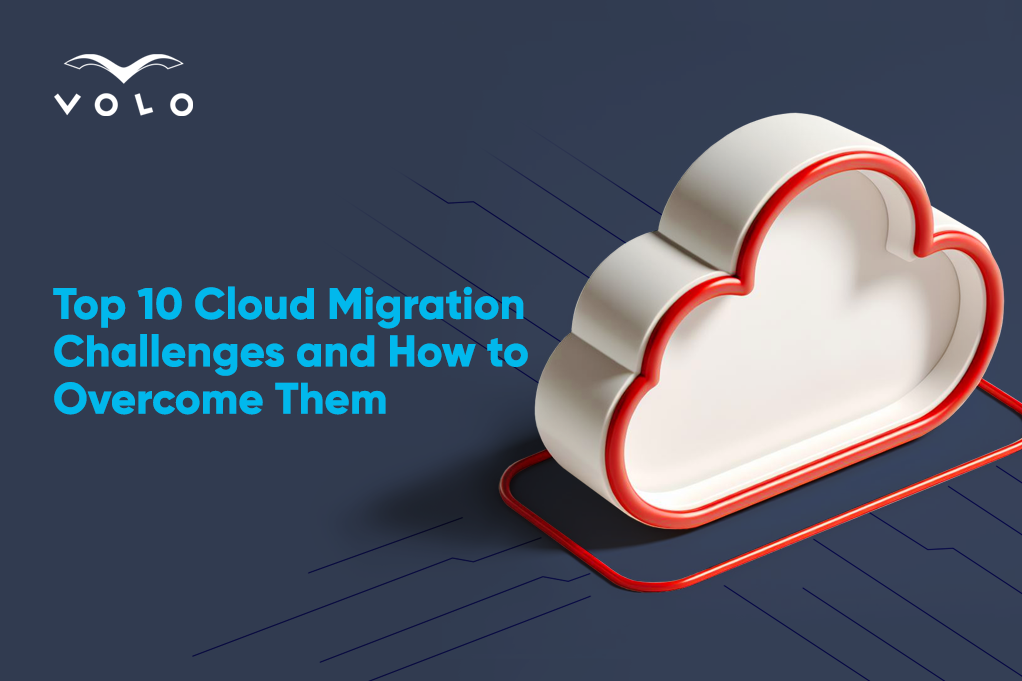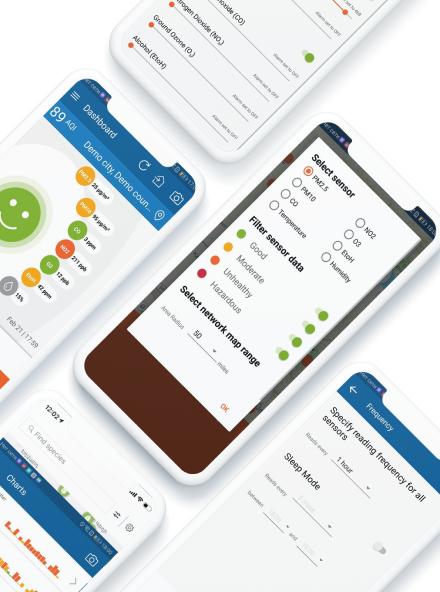
Top 10 Cloud Migration Challenges and How to Overcome Them
23 Aug 2024

Did you know that having at least 60% of your workload moved to the cloud will increase your profit growth by about 11.2% every year?
While this sounds great and motivating, the opposite also holds true - about one-third of cloud migrations fail, and only 1 in 4 organizations manages to meet their cloud migration deadlines.
This happens due to lack of experience, poor strategy planning, and the inability to handle cloud migration challenges wisely. On this note, let’s dive deeper into the matter and look into the details of the most common cloud migration problems and how you can overcome them without harming the business operations of your organization.
The Main Cloud Migration Challenges and Their Solutions
At the end of the day, the long-term benefits of cloud migration outweigh the issues and problems that it can bring with and that is why the majority of businesses have long resorted to migrating their data and applications to the cloud. Thanks to the improved efficiency, productivity, accessibility, and security that the cloud comes with, it’s no wonder that the challenges are often overlooked.
This is not to say that you should reconsider migrating to the cloud. The point is to carefully plan your cloud migration strategy in advance, before making the leap. To help you in your cloud migration journey, we have gathered a list of some of the main cloud migration challenges that businesses face. Additionally, we will also discuss the right ways to approach those challenges in order to overcome them successfully.
So, let’s dive right in.
Challenge #1: Scope Creep
Behind all the benefits and features that the cloud comes with hides a quite complex and multi-layered system. In fact, the cloud environment is way more complex than the on-premises setup. The sheer scope and complexity of migrating business applications and data to the cloud can be overwhelming and confusing for business owners. It’s not that easy to migrate data/apps that have been in the same environment for many years.
Such vast amount of work can cause the so-called scope creep. The latter means adding more work, i.e. new features, functionalities, and other requirements that are beyond the project scope, beyond the initially planned scope of work. This, in turn, leads to an endless cycle of work, delayed procedures, and unexpected expenses.
Solution
To address scope creep during cloud migration it’s crucial to define the clear objectives of the migration project from the start. This includes setting specific timelines, budget constraints, and expected outcomes. Afterward, make sure to develop a comprehensive migration plan that breaks down tasks into manageable phases. This way you and your team will be able to keep focus and avoid the addition of unnecessary features.
Establish governance mechanisms to control changes and additions to the project scope. For instance, organize regular review meetings and approval processes in case of scope changes.
Always keep all stakeholders involved in the process. This will help ensure alignment with business goals and eliminate the possibility for last-minute change requirements.
In order to prevent the migration process from unnecessary components, direct your focus toward the most critical and important applications and data and migrate those first.
And finally, adopt agile practices for more flexibility.
This is quite an overwhelming and complex process, so if you don’t think you or your in-house team can handle it, don’t risk it. It’s better to partner with experts and allow them to take care of your migration.
Challenge #2: Cloud Adoption Resistance
Sometimes it’s not easy to accept and adapt to changes and the cloud brings lots of drastic updates to what once was a customary environment - new systems, new processes, possible team changes - all of this can lead to resistance from your in-house team.
It’s not simply a change of systems. Cloud migration requires a shift in mindset, culture, and operations. One of the many reasons why you may encounter resistance from your team is the lack of knowledge of the upcoming disruptions. The pressure to upskill also causes resistance to modernization projects.
Solution
You need to have a robust change management plan in place. First of all, get the buy-in from your leadership. The encouragement and knowledge-sharing coming from your management team will create positive sentiments around migration.
Not to scare your team away, choose migration technologies and solutions that are user-friendly and can integrate with your existing tech stack painlessly.
Educate your employees through onboarding and training programs. Engage them in the process and motivate them to take part in it.

Challenge #3: Data Security and Compliance Risks
Moving decades of business data from a physical environment to the cloud can raise security concerns. It is natural because such a transition does make your data vulnerable. Besides, the cloud system also entails multiple accesses. You have to grant data access to many people working with you in order to easily share data within the organization. These are security threats that, if treated carelessly, can cause critical data leaks.
There is also the issue of compliance. There are industry-specific compliance standards that cannot be overlooked. Different industry sectors, e.g., healthcare or finance, have different legal requirements and regulations.
Solution
The cloud is considered a generally secure environment for data migration and preservation. However, it’s always better to be safe than sorry. This is why you need to ensure that you are migrating your data and apps through a secure path within the firewall. Don’t forget to encrypt your data and check the compliance of your strategy with the well-established industry standards.
On this note, check that your cloud environment adheres to the recommended and required compliance regulations and laws related to data privacy and security, otherwise you risk being fined and will end up spending time on the resolution of legal issues that could have been easily avoided.
Do frequent security audits and vulnerability checks to safeguard and future-proof your data from possible cyber attacks.
It’s always good to choose a cloud service provider that’s well-known in the market, is reliable, and a go-to choice by big businesses and corporations. A trustworthy vendor will offer multiple security features such as data encryption, identity and access management, and network security protocols.
Challenge #4: Legacy Systems
Legacy systems and applications can hinder your data migration process as well. Since they function on outdated technology and architecture, they can have dependencies that are not easy to untangle, resulting in cloud migration resistance.
Solution
Make a comprehensive list of all your existing systems. Identify the applications that can be retired or those that need modernization. Certain legacy applications can be easily modernized with very little change to the code. There are also apps that may need to be rearchitected. Plan this carefully, or rather, consult a specialist in order to choose the right modernization strategy for your legacy systems - one that will ensure long-term sustainability and scalability in the cloud environment.
Challenge #5: Downtime
One of the main challenges of cloud migration that scares business owners away is the possibility of downtime that can disrupt business continuity and hinder operational efficiency. Additionally, it can impact the overall productivity of your staff and result in poor customer experience.
Solution
There are a few ways you can handle downtime and disruption without causing much harm to business efficiency. First, it’s better to plan your migration processes during specifically scheduled maintenance hours. Secondly, make sure to implement failover mechanisms in order to have continuous availability. And lastly, always have well-established and clearly defined backout plans to be secure if migration problems arise. Don’t forget to let your stakeholders and customers know of the possible downtime - this is a responsible way to act.
Additionally, choose a cloud migration specialist/company that can handle such situations professionally, mitigating downtime risks and counseling you on the right steps to take to minimize operational disruptions.
Challenge #6: Skill Gaps
Many companies don’t have in-house tech teams and if they do, they still don’t have specialists with cloud migration expertise. This can highly slow down the migration process and result in a situation where you find yourself in a deadlock.
Solution
To break the deadlock in the fastest way possible, you should consider hiring an experienced cloud migration partner, a company that has experts specialized in cloud transformation. They can take up on your cloud migration process and let you and your internal tech team focus on your core business processes. If you still decide to have your tech team handle the migration, you can still use the guidance and counseling of cloud migration experts.
Another way to solve the matter is through providing your tech team with cloud migration training programs and educating them in the matter. If your team has time on their hands, then cloud certification programs can be a good investment in the long run. However, keep in mind that this can prolong your cloud migration process.
Challenge #7: Cloud Migration Costs
Cloud migration costs can be hard to manage too. Businesses often find it hard to predict and monitor their cloud spending in the most optimized manner. This happens because of a number of reasons:
- Cloud providers usually offer different services that come with complex pricing models that make it difficult for business owners to understand the cost implications of each service.
- Since the cloud is generally a scalable and largely flexible environment with evolving and changing workloads, it can again be hard to predict and manage the costs.
- When the cloud services are used by different independent teams within an organization without any alignment or coordination as to how they distribute and use the cloud resources, it can add up to the complicated cost management process.
- Misconfigurations and unused cloud resources can also bring about hidden and unexpected costs.
- Another way your cloud costs can skyrocket inconspicuously is if the provider introduces new features and functionalities and you fail to keep up with such updates.
Solution
The best way to address cost management issues is through the implementation of cost monitoring and reporting tools offered by cloud providers. Also, keep in mind to frequently check on your cloud resources and optimize them according to your needs. Carefully study the pricing models of your cloud provider and choose the one that meets your business needs and finances the best. Consider all costs, such as software licenses, hardware, materials, services, maintenance, operating costs, administrative expenses (staff training, team maintenance), and everything else linked with system monitoring. The ideal plan would be establishing a cloud cost governance framework and having your finance and IT teams go over it regularly to achieve the most efficient cost control process.

Challenge #8: Vendor Lock-In
Vendor lock-in occurs when a business becomes heavily dependent on a specific cloud service provider. As a result, the organization ends up with limited cloud flexibility and will be stuck in the given provider’s services and pricing. Additionally, such a dependency can make it challenging to switch to another provider.
Solution
To mitigate vendor lock-in risks, companies can adopt a multi-cloud or hybrid-cloud approach, use standardized APIs, leverage containerization, and regularly assess their technology choices. This way, you will be able to allocate workloads and applications across different cloud providers and never be dependent on a single vendor.
Challenge #9: Cloud Performance and Outcomes
At the end of the day, it is the final benefits and desired outcomes of cloud migration that you are looking forward to and investing so much time and resources for. Ensuring that all your goals and initial expectations are met is yet another cloud migration challenge that needs to be addressed way before the start of the cloud migration process.
Solution
To prevent poor post-migration outcomes, you need to balance performance and cost. Do thorough cloud capacity planning, analyze and measure the performance of your applications against predictive demand. This will help you facilitate and allocate the right amount of resources needed to meet the demand.
Challenge #10: DevOps Transformation
DevOps transformation is necessary in helping you reap all the benefits of your cloud migration and app modernization processes. Without the implementation of DevOps or IT infrastructure management practices, you risk being stuck in a static environment that can resemble the previous on-premises one. As a result, you invest big in the cloud and end up without the expected benefits and improvements.
DevOps transformation enables seamless collaboration between development and operations teams, automates processes for efficiency, and ensures faster delivery of applications - these are all crucial for leveraging the full potential of cloud infrastructure.
Solution
Start with implementing such IT infrastructure management practices as continuous integration/continuous deployment (CI/CD), infrastructure as code (IaC), and automated testing. This will help maximize the benefits of your migration and modernization efforts.
Consider asking for help from professional DevOps specialists to build a secure and efficient cloud operating environment, select the right tools, and deliver coaching to encourage a DevOps mindset in your in-house team.
Parting Thoughts
As you can see, cloud migration is not for the faint of heart and in order to be a success, you need to address your cloud enablement challenges head on. With thorough planning, proper training, and embracing IT infrastructure management practices, you can overcome these challenges and realize the full potential of cloud infrastructure.
FAQ
1. Which of the following is the top challenge of cloud migration?
The top challenge of cloud migration varies from organization to organization and is highly dependent on specific circumstances. However, data security and compliance issues are often considered one of the most critical challenges of cloud migration. Ensuring the safety and security of your data before, during and after the migration, all the while keeping up with the required laws and regulations is of paramount importance for all businesses. The smallest security breach can have irreversible consequences for your business, causing legal issues, financial penalties, and what's probably the worst, reputational damage.
Some companies find it the hardest to handle such cloud migration issues as scope creep and migration costs. These can get things more complicated especially if you fail to do clear planning and budgeting.
2. What are the 4 R's of cloud migration?
Here are the commonly accepted 4 R's of cloud migration: - Rehost (Lift and Shift): This is when you choose to move your applications to the cloud with no changes.
- Refactor (Re-architect): In this case, you need to modify your applications and optimize them to be fit for the cloud.
- Replatform (Revise): When replatforming, you migrate your applications to the cloud with moderate changes.
- Replace (Repurchase): Here you simply replace your legacy app with a SaaS solution that delivers the same or similar features and functionalities.
3. What are the limitations of cloud migration?
Other than the above-listed cloud migration issues, there are not many remaining cloud migration limitations that could cause serious problems on your cloud journey. Perhaps, a last limitation we can mention here is the variability of cloud performance. The latter can sometimes be inconsistent, with potential latency and bandwidth issues which can affect your applications. However, this should not be a concern - modern technologies come with constantly improving and evolving cloud solutions. Simply, make sure to choose the right vendor and this will hardly ever become an actual issue or limitation for your business.
More helpful resources:
- How to Streamline the Process of Migration to the Cloud?
- Do Legacy Systems Block Your Business Growth?
- Does My Enterprise Need Digital Transformation?
- Navigating Digital Transformation Services: A Guide for Industry Leaders in 2024
- What's Driving App Modernization?
- Microsoft Azure vs. AWS vs. Google Cloud: Which One to Choose?
- 7 Benefits of Azure Cloud Migration from On-Premises Data Centers
- 7 Strategies for Modernizing Your Business Apps
- VOLO's Approach to Legacy Transformation
- Updating Your Legacy Software: Everything You Need to Know



